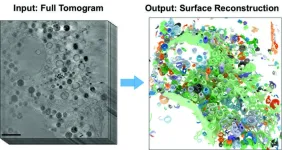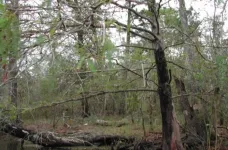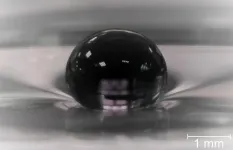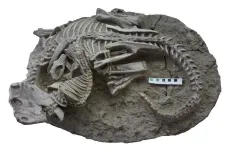(Press-News.org)
Lewy body disease is the second most common neurodegenerative disease after Alzheimer's disease. A research group from Lund University has now shown that the disease can be detected before symptoms appear, using a spinal fluid test. The studies are published in Nature Medicine, where the researchers also demonstrate that reduced sense of smell is strongly linked to Lewy body disease even before other clear symptoms have developed. The findings are also reported simultaneously at the Alzheimer’s Association International Conference.
Lewy body disease is an umbrella term for Parkinson's disease and Lewy body dementia. When movement difficulties are more dominant, the disease is called Parkinson's disease, and when cognitive impairments are dominant, the term Lewy body dementia is used.
”Lewy body disease is caused by the misfolding of the alpha-synuclein protein in the brain. When this happens, the protein clumps together and forms what are called Lewy bodies, which damage the nerve cells”, says Oskar Hansson, Professor of Neurology at Lund University andsenior consultant at Skåne University Hospital.
Until very recently, it was not possible to determine with certainty, whether a person with movement difficulties or cognitive impairments had Lewy bodies in the brain until after their death. But now, with a spinal fluid test, it is possible to see if the person has the misfolded protein. Oskar Hansson's research group has just completed a large study involving over 1,100 individuals, none of whom initially showed any cognitive impairments or motor difficulties. However, it turned out that nearly ten percent had Lewy bodies in their brains according to the spinal fluid test. Therefore, it is possible to detect Lewy body disease even before the first symptoms appear.
”Despite the participants not having any cognitive or neurological problems at the beginning of the study, we observed that those with Lewy bodies in the brain subsequently experienced a decline in their cognitive functions over time. They were also the ones who developed Parkinson's disease or Lewy body dementia in the coming years”, says Oskar Hansson.
An interesting finding was also that Lewy bodies are strongly associated with a reduced sense of smell even before other symptoms have developed. The sense of smell also deteriorates as the disease progresses. The correlation is so clear that it could be justified to screen individuals over 60 years of age with a smell test and then proceed with testing spinal fluid if one wants to detect Lewy body disease early, according to Oskar Hansson.
”Several drugs targeted at Lewy bodies are currently being developed, with the hope of slowing down the disease. Most likely, this type of medication has the best chance of being effective if administered early in the course of the disease. If symptom-free individuals with reduced sense of smell were identified, and the test for Lewy bodies was positive, they could participate in drug trials aimed at developing new medications that can halt the disease early”, says Oskar Hansson.
However, Oskar Hansson emphasizes that there are many causes of loss of smell that are not related to Lewy body dementia, which is why testing with the spinal fluid test is important.
Brain changes that interact
In a second publication, the research group also studied over 800 individuals with cognitive difficulties and found that around one-fourth of them had a test result indicative of Lewy body disease. Approximately 50 percent of those with Lewy body disease also had accumulation of the proteins amyloid and tau, which are associated with Alzheimer's disease. For individuals who had both amyloid and tau, as well as Lewy bodies, the disease progressed faster. This suggests that these brain changes interact, which is of great clinical importance for predicting the patient's prognosis.
”I believe that this test for Lewy body disease will start being used relatively soon to improve the diagnostic and prognostic work-up in clinics that take care of individuals with movement disorders and cognitive symptoms”, says Oskar Hansson.
Oskar Hansson hopes that, just like for Alzheimer's disease, it will be possible to develop a blood test for Lewy body disease. One of the challenges with this is that the concentration of proteins originating from the brain is often 100-1000 times lower in the blood than in the spinal fluid, which can make it difficult to detect Lewy body changes.
“On the other hand - five years ago we hardly believed it would happen for Alzheimer's disease, and now it's a reality. So, we are investing a lot in refining the methodology, and I am optimistic about the future”, he concludes.
END
The landmark United States Supreme Court ruling in Loving v. Commonwealth of Virginia abolished bans on interracial marriage in the United States in 1967, but a new academic paper from Rice University and Texas A&M University said an uptick in interracial relationships since then has not ended discriminatory tendencies, even among individuals who are in these romantic partnerships.
The paper, “Mixing races, maintaining racism? Considering the connection between interracial families, social distance and racial inequality,” is online and will appear in an upcoming edition ...
BESSY II's high-brilliance X-rays can be used to produce microscopic images with spatial resolution down to a few tens of nanometres. Whole cell volumes can be examined without the need for complex sample preparation as in electron microscopy. Under the X-ray microscope, the tiny cell organelles with their fine structures and boundary membranes appear clear and detailed, even in three dimensions. This makes cryo x-ray tomography ideal for studying changes in cell structures caused, for example, by external triggers. Until now, however, the evaluation of 3D tomograms has required largely manual and labour-intensive data ...
A bifacial perovskite solar cell, which allows sunlight to reach both sides of the device, holds the potential to produce higher energy yields at lower overall costs, according to scientists at the U.S. Department of Energy’s National Renewable Energy Laboratory (NREL).
The dual nature of a bifacial solar cell enables the capture of direct sunlight on the front and the capture of reflected sunlight on the back, allowing this type of device to outperform its monofacial counterparts.
“This perovskite cell can operate very ...
FOR IMMEDIATE RELEASE
Contact:
Colleen McDonald, Sr. Consultant - Earned Media
414.801.3146 | cmcdonald@mcw.edu
Medical College of Wisconsin scientist and international team awarded $13 million NIH program project grant to study calcifications in diseases of aging
Dr. Francesca Marassi and collaborators garner $13 million NIH grant to study misplaced calcified deposits that are a misunderstood factor in common diseases of aging
Milwaukee, Wis., July 18, 2023 – Francesca Marassi, PhD, professor and chair of ...
Pregnant patients who received some of their prenatal care during the COVID-19 pandemic in a combination of virtual and in-office visits — known as multimodal prenatal care — had similar health outcomes as those who were seen mostly in person before the pandemic, according to a large new study of more than 151,000 births from the Kaiser Permanente Division of Research.
The analysis compared pregnancy care, delivery, and outcomes for 3 different time periods: delivery before the pandemic (July 2018 to February 2020), early pandemic (March 2020 to December 2020), and mid-pandemic (December 2020 to October 2021). ...
Climates are changing in wetland ecosystems around the world. A research collaboration between the U.S. Geological Survey and Clayton State University examined the impact of historical land use on these key environments and proposed employing freshwater delivery techniques developed for inland wetlands to help manage coastal systems.
In a recently published paper, the research team emphasized the impact of human use of land over time, focusing specifically on water delivery to inland wetlands. The ...
Developing Novel & Safe Contrast Agent Platform For Photoacoustic Imaging
Remi Veneziano, Assistant Professor, Bioengineering, received funding from the National Science Foundation I-Corps Program for the project: "Towards a clinically translatable and standardized tissue ‘paint/contrast agent’ for photoacoustic imaging."
Veneziano is collaborating with Shrishti Singh, Postdoctoral Research Fellow, Bioengineering, and Elizabeth Pyle, Life Science Business Mentor, Innovation Commercialization Assistance Program (ICAP), Virginia Small Business Development ...
Lowder Receives Funding For Indiana Justice Reinvestment Advisory Council Racial Equity Project
Evan Lowder, Assistant Professor, Criminology, Law and Society, received funding for: "Indiana Justice Reinvestment Advisory Council Racial Equity Project."
The goals of this study are to understand criminal-legal decision points that may be contributing to racially disparate outcomes and to further data collection efforts at the state and local levels that can facilitate improved tracking of decisions and outcomes in the criminal-legal system.
The broader ...
WASHINGTON, July 18, 2023 – Self-sustained levitation of millimeter-sized droplets was recently discovered by researchers at Tyumen State University, in Russia, during an experiment to select combinations of immiscible liquids, which don’t form homogeneous mixtures.
Researchers Natalia Ivanova and Denis Klyuev noticed something amazing happen: Droplets of butyl alcohol, after being detached from the syringe needle, levitated above the surface of the layer of another liquid without collapsing onto it for a long period of time.
In Applied Physics Letters, from AIP Publishing, ...
Ottawa, July 18, 2023 – Canadian and Chinese scientists have described an unusual fossil from around 125 million years ago that shows a dramatic moment in time when a carnivorous mammal attacked a larger plant-eating dinosaur.
“The two animals are locked in mortal combat, intimately intertwined, and it’s among the first evidence to show actual predatory behaviour by a mammal on a dinosaur,” explains Dr. Jordan Mallon, palaeobiologist with the Canadian Museum of Nature and co-author on the study published today in the journal Scientific Reports.
The ...




